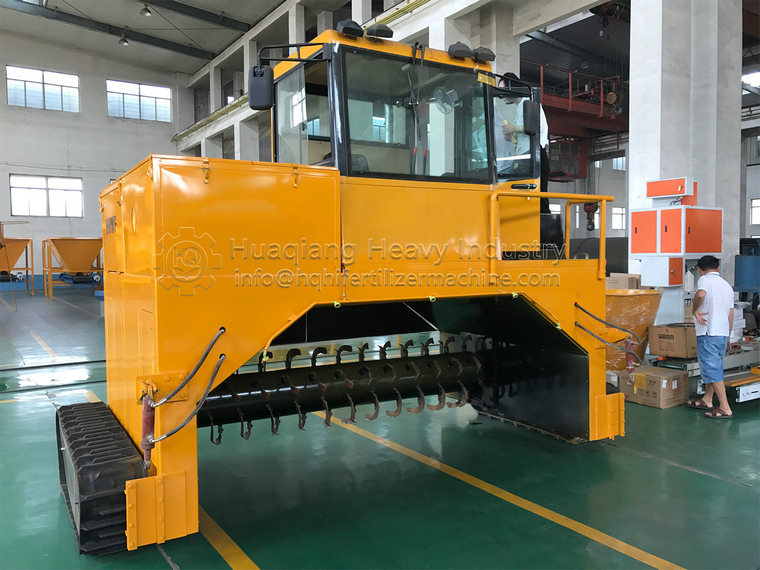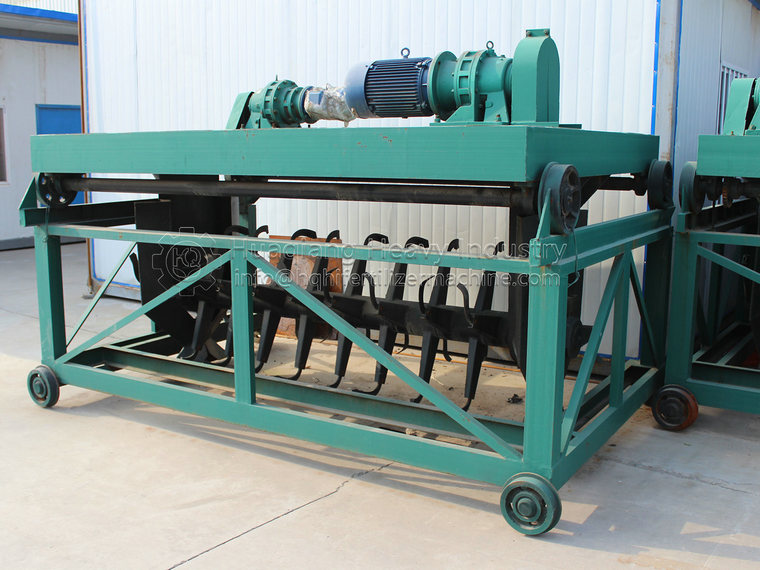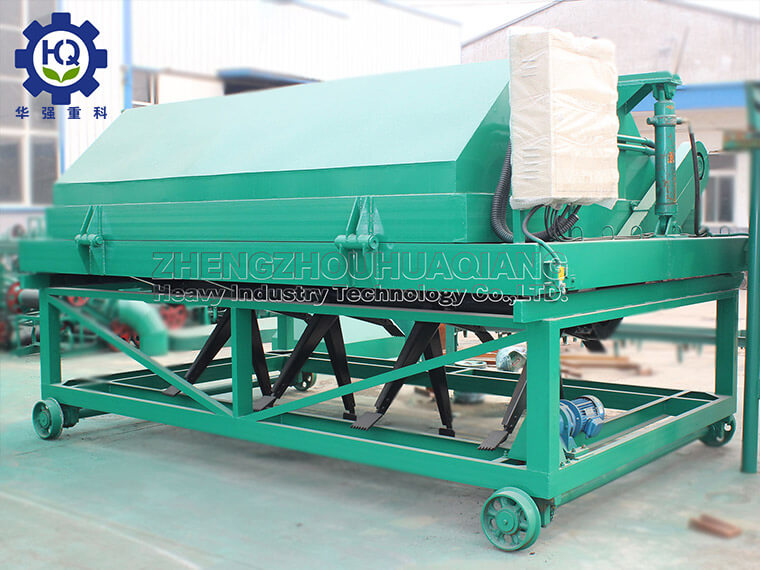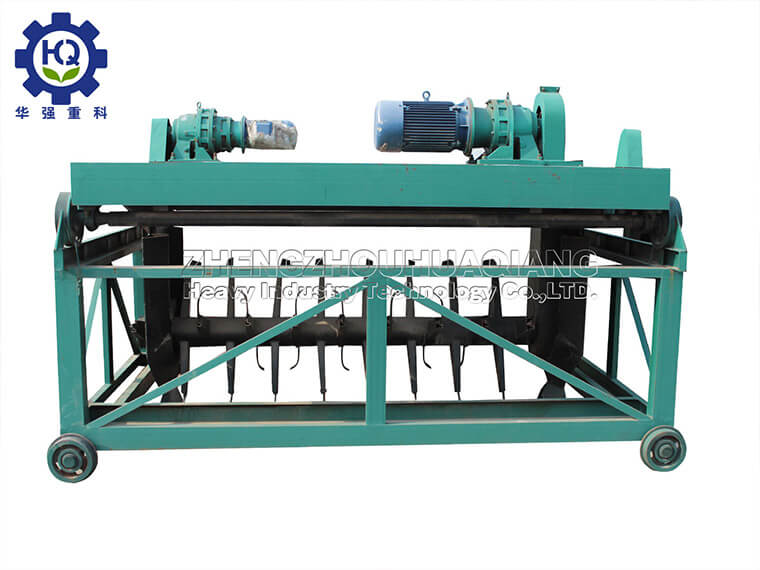The organic fertilizer turning machine plays a crucial role in the process of processing wet materials (such as livestock manure, kitchen waste, biogas residue, and other high humidity organic waste) into fertilizers. This type of wet material has a high moisture content and is difficult to handle using traditional composting methods. However, organic fertilizer composting machines can effectively address this challenge. The following is the specific processing procedure:

1. Material pretreatment
Dehydration: High humidity materials first need to undergo solid-liquid separation to reduce their moisture content to an appropriate level for subsequent processing. For livestock and poultry manure, an extruder or centrifuge can be used for preliminary dehydration; For kitchen waste, water can be reduced through pressing and other methods.
2. Add auxiliary materials
Mixing water absorbing materials: In order to balance moisture and provide the carbon source required by microorganisms, it is necessary to add auxiliary materials with strong water absorption properties such as straw, sawdust, rice husks, etc., and adjust the carbon nitrogen ratio (C/N ratio) to about 30:1 to promote microbial growth.
3. Early stage of fermentation
Loading: Place the pre processed material evenly on the fermentation bed or in the fermentation tank to form a fermentation pile.
4. Ventilation and flipping
Intervention of compost turning machine: The organic fertilizer compost turning machine uses its specially designed mixing and flipping structure to pass through the material pile, turning the bottom material to the surface while introducing fresh air to ensure sufficient oxygen supply, promote aerobic microbial activity, and accelerate organic matter decomposition.
5. Control temperature and humidity
Temperature monitoring: Continuously monitor the temperature of the stack through internal or external sensors to ensure it remains between 50 ° C and 65 ° C, which is the optimal temperature range for most fermentation bacteria.
Humidity adjustment: During the flipping process, add water moderately or adjust the evaporation of water by flipping to maintain a suitable humidity for the entire stack, neither too wet nor too dry.
6. Regularly flip the pile
Frequent flipping: Every few days to a week, use a organic fertilizer compost turning machine for thorough flipping to ensure that all materials have sufficient aeration and fermentation opportunities, avoiding local overheating or hypoxia.
7. Maturity stage
Observation: As the fermentation progresses, the material gradually becomes dark, odorless, and has a loose texture, indicating that the fermentation is basically complete.
8. Post processing
Crushing and screening: The fermented material is further processed by a crusher to make it smaller particles, which is beneficial for later use.
Drying: Use sun exposure or a dryer to reduce the moisture content of the final product, making it easier to store and transport.
summary
The organic fertilizer turning machine effectively solves the problem of wet material processing by optimizing fermentation conditions, not only improving fermentation efficiency but also ensuring the quality of the final fertilizer. The application of this technology is widely used in the resource utilization of agricultural waste, helping to protect the ecological environment and promote sustainable agricultural development.
1. Material pretreatment
Dehydration: High humidity materials first need to undergo solid-liquid separation to reduce their moisture content to an appropriate level for subsequent processing. For livestock and poultry manure, an extruder or centrifuge can be used for preliminary dehydration; For kitchen waste, water can be reduced through pressing and other methods.
2. Add auxiliary materials
Mixing water absorbing materials: In order to balance moisture and provide the carbon source required by microorganisms, it is necessary to add auxiliary materials with strong water absorption properties such as straw, sawdust, rice husks, etc., and adjust the carbon nitrogen ratio (C/N ratio) to about 30:1 to promote microbial growth.
3. Early stage of fermentation
Loading: Place the pre processed material evenly on the fermentation bed or in the fermentation tank to form a fermentation pile.
4. Ventilation and flipping
Intervention of compost turning machine: The organic fertilizer compost turning machine uses its specially designed mixing and flipping structure to pass through the material pile, turning the bottom material to the surface while introducing fresh air to ensure sufficient oxygen supply, promote aerobic microbial activity, and accelerate organic matter decomposition.
5. Control temperature and humidity
Temperature monitoring: Continuously monitor the temperature of the stack through internal or external sensors to ensure it remains between 50 ° C and 65 ° C, which is the optimal temperature range for most fermentation bacteria.
Humidity adjustment: During the flipping process, add water moderately or adjust the evaporation of water by flipping to maintain a suitable humidity for the entire stack, neither too wet nor too dry.
6. Regularly flip the pile
Frequent flipping: Every few days to a week, use a organic fertilizer compost turning machine for thorough flipping to ensure that all materials have sufficient aeration and fermentation opportunities, avoiding local overheating or hypoxia.
7. Maturity stage
Observation: As the fermentation progresses, the material gradually becomes dark, odorless, and has a loose texture, indicating that the fermentation is basically complete.
8. Post processing
Crushing and screening: The fermented material is further processed by a crusher to make it smaller particles, which is beneficial for later use.
Drying: Use sun exposure or a dryer to reduce the moisture content of the final product, making it easier to store and transport.
summary
The organic fertilizer turning machine effectively solves the problem of wet material processing by optimizing fermentation conditions, not only improving fermentation efficiency but also ensuring the quality of the final fertilizer. The application of this technology is widely used in the resource utilization of agricultural waste, helping to protect the ecological environment and promote sustainable agricultural development.
Raw material collection: Regularly clean the feces in the poultry and livestock house, and try to avoid mixing with other non organic substances as much as possible.
De clutter and screening: Use mechanical means to remove impurities such as plastics, stones, metal parts, etc. from feces, and preliminarily screen particles of different sizes.
Moisture regulation: Use a solid-liquid separator to adjust the moisture content of feces, generally maintained at 40% -60%, which is beneficial for subsequent fermentation.
2. Fermentation
Add auxiliary materials: According to the type of feces, add carbon based materials such as sawdust, straw, rice husk, etc. in appropriate amounts, adjust the C/N ratio to about 25:1, and accelerate microbial fermentation.
Inoculate fermentation agent: Add efficient fermentation bacteria such as EM bacteria, photosynthetic bacteria, etc., and start the fermentation process.
Temperature and flipping: Keep the stack temperature at 55 ℃~65 ℃, flip the stack every few days to ensure uniform fermentation and sufficient oxygen supply.
3. Post fermentation and aging
Maturity test: When the temperature of the heap begins to decrease, there is no odor, and the color becomes darker, it indicates that fermentation is basically completed.
Aging stage: further placed for several weeks to thoroughly decompose residual organic matter and improve fertilizer efficiency stability.
4. Crushing and mixing
Use a grinder to crush the fermented material for subsequent mixing and granulation.
Mix the crushed organic matter with mineral additives, trace elements, etc. to ensure nutritional balance.
5. Granulation
Choose a suitable organic fertilizer granulator, such as disc granulator, extrusion granulator, or drum granulator, and customize the particle size and shape according to your needs.
6. Drying and Cooling
Use a dryer or natural air drying to reduce the moisture content of the particles to below 10% for long-term storage.
The cooling process can be carried out by fan blowing or natural indoor cooling to ensure that particles are not damaged due to overheating.
7. Screening and packaging
Screen out oversized or undersized particles that do not meet the requirements to ensure uniform specifications of the finished product.
Use a professional packaging machine for quantitative packaging, label and store for sale.
Key Point Tips
The entire production process needs to pay attention to environmental hygiene and avoid secondary pollution.
Strictly follow national standards and local regulations to ensure the safety and compliance of organic fertilizers.
Consider installing waste gas and liquid treatment systems to achieve clean production and reduce the impact on the surrounding environment.
The construction of organic fertilizer production lines for poultry and livestock manure should be based on actual conditions and market demand, selecting appropriate technical routes and equipment configurations to achieve the goals of high efficiency, environmental protection, and economy. With the advancement of technology, continuous optimization of process flow and equipment updates can continuously improve the quality and production efficiency of organic fertilizers.
.jpg)



.jpg)

.jpg)


.jpg)